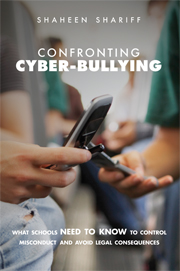 Confronting Cyber-Bullying
Confronting Cyber-Bullying Book contents
- Frontmatter
- Contents
- Figures
- Tables
- Preface
- Acknowledgments
- 1 Cyber Misconduct: Who Is Lord of the Bullies?
- 2 Profile of Traditional and Cyber-Bullying
- 3 Cyber Libel or Criminal Harassment: When Do Kids Cross the Line?
- 4 Student Free Expression: Do the Schoolhouse Gates Extend to Cyberspace?
- 5 Fostering Positive School Environments: Physical and Virtual
- 6 Censoring Cyberspace: Can Kids Be Controlled?
- 7 The Tragedy of the Commons: Lessons for Cyberspace?
- 8 Cyber Collaboration: Models for Critical Legal Pluralism in Teacher Education Programs
- Notes
- Cases
- Index
- References
1 - Cyber Misconduct: Who Is Lord of the Bullies?
Published online by Cambridge University Press: 02 July 2009
- Frontmatter
- Contents
- Figures
- Tables
- Preface
- Acknowledgments
- 1 Cyber Misconduct: Who Is Lord of the Bullies?
- 2 Profile of Traditional and Cyber-Bullying
- 3 Cyber Libel or Criminal Harassment: When Do Kids Cross the Line?
- 4 Student Free Expression: Do the Schoolhouse Gates Extend to Cyberspace?
- 5 Fostering Positive School Environments: Physical and Virtual
- 6 Censoring Cyberspace: Can Kids Be Controlled?
- 7 The Tragedy of the Commons: Lessons for Cyberspace?
- 8 Cyber Collaboration: Models for Critical Legal Pluralism in Teacher Education Programs
- Notes
- Cases
- Index
- References
Summary
“Yo Jaysus, your ass is drippin,” says Max Lechuga. He's the stocky guy in class, you know the one. Fat, to be honest, with his inflatable mouth. “Stand clear of Jaysus' ass, the fire department lost another four men up there last night.” The Gurrie twins huddle around him, geeing him on…. The class detonates through its nose…. Jesus abandons his desk with a crash and runs from the room…. Then Max Lechuga gets out of his chair, and goes to the bank of computer terminals by the window. One by one, he activates the screen-savers. Pictures jump to the screen of Jesus naked, bent over a hospital-type gurney.
(Pierre, 2003, pp. 231–233)The courts of law would shit their pants laughing…. But here's why they'd laugh: not because they couldn't see … but because they knew nobody else would buy it. You could stand before twelve good people … and they wouldn't admit it. They'd forget how things really are, and slip into TV-movie mode where everything has to be obvious.
(ibid., p. 51)INTRODUCTION
Pierre's Vernon God Little illustrates the tortuous power of words and images; the anger, hate, and pain they can promote; and their transformation into depictions and online permanence for viewing by an infinite and global audience, from classroom to cyberspace. The narrative depicts peer classroom bullying and cyber-bullying at its core.
- Type
- Chapter
- Information
- Confronting Cyber-BullyingWhat Schools Need to Know to Control Misconduct and Avoid Legal Consequences, pp. 1 - 21Publisher: Cambridge University PressPrint publication year: 2009
